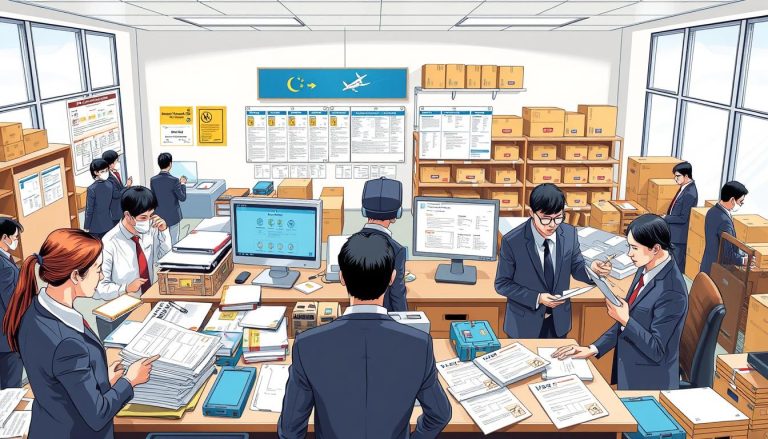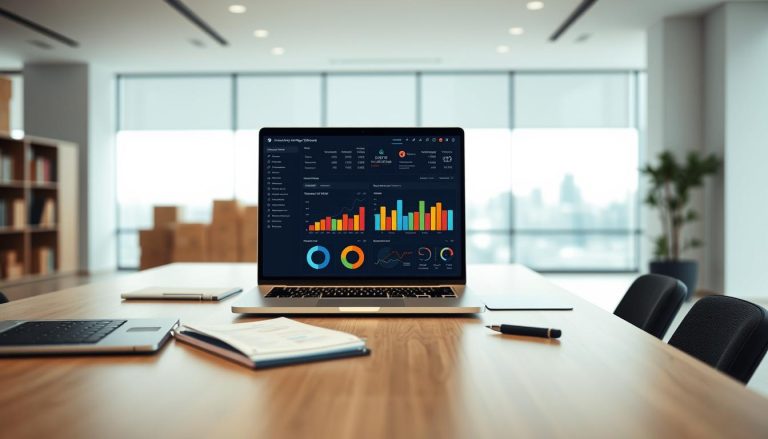Exploring 3PL Meaning in Modern Logistics
In the U.S., companies are dealing with tighter delivery windows, higher transportation costs, and growing customer expectations. This piece delves into the 3pl meaning, providing a clear third-party logistics definition. It also explains what 3pl entails in real terms for those making decisions. It offers insights into the 3pl industry, directly impacting operations and financial results.
At its essence, third-party logistics means outsourcing transportation, warehousing, and order fulfillment to a specialized provider. Readers will understand how 3pl operates through assessment, integration, execution, and continuous improvement. The discussion also covers various provider types, from those specializing in transportation management to eCommerce fulfillment and customs-focused forwarders.
It’s shown how scale, carrier rate leverage, and technology like TMS, WMS, OMS, and visibility platforms can cut costs and speed up delivery. Examples include AutoStore deployments with DHL Supply Chain, GEODIS supporting Maurices, THG, and Arvato. In these cases, throughput increased, and picking accuracy approached 100 percent.
The aim is to provide clear analysis that explains what 3pl is, offers verified industry insights, and details how 3pl functions in modern logistics without using technical jargon. The sections that follow will guide you through evaluation and action.
Third-Party Logistics Definition and What Is 3PL
The third-party logistics definition revolves around hiring an external provider to oversee logistics across the supply chain. In essence, what is 3pl? It’s a business model that outsources transportation, warehousing, and fulfillment to a specialized entity. This model ensures cost management aligns with service quality across various channels.
Understanding third party logistics
Grasping third-party logistics starts with understanding its scope. A provider manages carrier selection, route optimization, and shipment tracking through a Transportation Management System (TMS). They also oversee storage, receiving, and putaway with a Warehouse Management System (WMS). An Order Management System (OMS) coordinates orders across different sales channels.
A detailed 3pl services explanation encompasses picking, packing, and shipping, along with handling returns and reverse logistics. Many partners extend their services to include kitting, assembly, labeling, and customization. These activities support retail, marketplace, and direct-to-consumer workflows.
Core functions: transportation, warehousing, and fulfillment
- Transportation: Negotiated rates, mode and lane planning, and real-time tracking for parcel, Less-than-Truckload (LTL), Full Truckload (FTL), and international freight.
- Warehousing: Inventory storage, cycle counts, slotting, and compliance for regulated goods where applicable.
- Fulfillment: Order orchestration, pick-pack-ship, value-added services, and returns processing tied to service levels.
| Function | Operational Focus | Key Technologies | Typical KPIs |
|---|---|---|---|
| Transportation | Carrier mix, route planning, cost-to-serve | TMS, carrier APIs, tracking tools | On-time delivery, cost per shipment, damage rate |
| Warehousing | Space utilization, inventory accuracy, throughput | WMS, barcode/RFID, labor planning | Inventory accuracy %, dock-to-stock time, lines per hour |
| Fulfillment | Order accuracy, speed, packaging quality | OMS, pick-path optimization, automation | Order accuracy %, same-day pick rate, cost per order |
Why businesses outsource logistics operations
Companies opt for 3PL to cut costs through scale and better carrier relationships. This approach reduces the need for capital in buildings, racking, robotics, and software, keeping cash reserves intact.
Outsourcing frees up teams to focus on product design, merchandising, and brand growth. As volumes increase, in-house setups face complexity challenges. A Radial survey in March 2025 found over half of brands outsource fulfillment once revenue hits $50 million. This highlights the operational benefits of partnering, providing a clear 3pl meaning and measurable service and cost improvements.
3PL Meaning
3pl meaning refers to a partnership where a specialized provider handles logistics fully or in parts. They manage inventory, distribute to stores or directly to consumers, and fulfill online orders. Many have their own warehouses, shelving, and automation systems. A 4PL, on the other hand, manages providers without owning assets.
This partnership involves a provider supplying trained staff, standard procedures, and carrier networks. They strategically place inventory to meet service and speed targets in the U.S. They also integrate with platforms like Shopify and Amazon for order management and KPI tracking.
3pl meaning encompasses technology and performance management for cost savings, reliability, and customer satisfaction. Providers use TMS, WMS, and OMS to manage transportation, warehousing, and fulfillment. This helps balance capacity, service levels, and network reach, providing insights for procurement and finance teams.
| Aspect | 3PL Role | Operational Impact | Technology Examples |
|---|---|---|---|
| Inventory Control | Owns/operates warehouses and applies SOPs | Higher accuracy, lower shrink, faster turns | WMS, cycle counting, slotting analytics |
| Fulfillment | Picks, packs, and ships DTC and retail orders | Improved on-time dispatch and fill rates | OMS, rate shopping, carrier label APIs |
| Transportation | Contracts carriers and optimizes routing | Reduced freight spend and dwell time | TMS, load planning, real-time tracking |
| Network Design | Positions stock near demand hubs | Shorter transit and predictable SLAs | Demand forecasting, heat maps, KPIs |
| Systems Integration | Connects sales channels and ERPs | Order sync, inventory sync, status transparency | Shopify, Adobe Commerce, NetSuite connectors |
| Governance | Defines SLAs and performance dashboards | Clear accountability and continuous improvement | Scorecards, alerts, exception management |
These elements align with the third party logistics definition, showing insights into asset use, labor skills, and data clarity. It’s more than just outsourcing; it’s a technology-enabled partnership with measurable results.
How Does 3PL Work Across the Supply Chain
Businesses assess 3PL by examining procurement, warehousing, and transportation needs. This process clarifies costs, service levels, and data flow. It provides a detailed 3PL company overview and builds practical knowledge for those exploring third-party logistics.
Assessment and selection of a 3PL partner
Teams evaluate order volumes, SKU velocity, packaging rules, and target transit times. They assess providers based on vertical expertise, network density, automation, and references from brands like Nike, Target, or Walmart.
Criteria include facility locations, labor models, carrier mixes, EDI/API maturity, and proven SLAs. A structured RFI/RFP process narrows candidates and quantifies total landed cost.
Integration and data sharing between systems
ERP and eCommerce platforms like NetSuite, Shopify, and Adobe Commerce integrate with the 3PL’s WMS, OMS, and TMS. This integration enables inventory sync, order ingestion, rate shopping, label creation, and event tracking from dock-to-door.
Data governance defines ownership for SKUs, units of measure, and reason codes. Robust APIs, EDI 940/945/856, and carrier webhooks support real-time status and accurate billing—essential for 3PL operations.
Planning, execution, and day-to-day operations
Engineers design slotting by velocity and cube, align pick paths, and model labor by shift. Wave planning, pick-pack-ship, and compliant labeling feed parcel and LTL routing through carriers like UPS, FedEx, and USPS.
Daily operations include receiving, putaway, cycle counts, kitting, and returns processing. Clear SOPs uphold SLAs for order accuracy and on-time shipment, reflecting a concise 3PL company overview in action. This strengthens understanding of third-party logistics.
Monitoring, reporting, and continuous improvement
Dashboards track order accuracy, on-time shipment, dock-to-stock time, and inventory accuracy. Exception logs drive root-cause analysis and corrective actions with weekly and monthly reviews.
Continuous improvement focuses on process redesign, slotting refinements, and selective automation. This closed loop demonstrates how 3PL works end-to-end while sustaining a data-led 3PL company overview for ongoing governance and understanding third-party logistics.
3PL Services Explanation and Common Offerings
Professionals often seek a clear 3pl services explanation that links practice to performance. This section details the operational aspects of 3pl, aligns its meaning with daily execution, and incorporates insights from mainstream logistics in the United States.
Transportation and freight management
Third-party providers manage carrier selection, contract negotiation, and rate auditing across various modes. They apply route optimization, consolidation, and shipment tracking for both domestic and international moves. This often involves leveraging multi-carrier APIs and EDI with major carriers like UPS, FedEx, DHL, and LTL carriers.
This explanation shows how providers model transit time, cost, and service level trade-offs. They aim to meet budget and SLA targets, grounding 3pl in measurable deliverables.
Warehousing, distribution, and order fulfillment
Facilities, whether owned or leased, support storage, slotting, and replenishment with defined pick paths. Fulfillment processes include batch, wave, or zone picking; packing; and shipping through national and regional carriers. Compliance labels for retailers like Walmart and Target are standardized.
These workflows align with 3pl meaning as a managed service that executes distribution at scale. They maintain accuracy and speed during peaks.
Inventory management and demand forecasting
WMS and OMS platforms provide real-time stock visibility, cycle counting, safety stock settings, and automated replenishment rules. Forecast alignment reduces stockouts and excess inventory, improving cash conversion cycles.
Applied analytics, such as ABC classification and service-level optimization, translate 3pl industry insights into practical inventory policy.
Returns management and reverse logistics
Returns flow includes receiving, inspection, grading, refurbishment, or certified disposal. Items approved for resale are restocked with updated condition codes. Integrations with Loop and Happy Returns streamline customer initiation and label creation.
This closed-loop approach lowers write-offs and shortens recovery time, illustrating what is 3pl beyond outbound shipping.
Value-added services: kitting, labeling, customization
Providers handle kitting, light assembly, custom packaging, gift wrapping, and labeling to meet channel or retailer mandates. Projects support marketplace bundles on Amazon or compliance for Costco and Home Depot.
These tasks extend 3pl meaning from storage to merchandising readiness, improving on-shelf and online conversion.
Technology enablement: TMS, WMS, OMS, visibility
TMS manages transportation planning and optimization. WMS governs warehouse execution and labor allocation. OMS orchestrates orders across channels. Visibility platforms supply KPIs, exceptions, and predictive ETAs that inform service levels and cost control.
Such tooling converts 3pl industry insights into standardized workflows and reliable reporting.
| Service Area | Primary Tools | Key Activities | Operational Metric | Business Outcome |
|---|---|---|---|---|
| Transportation | TMS, carrier portals, EDI | Carrier selection, routing, consolidation | Cost per shipment; on-time % | Lower freight spend; SLA adherence |
| Warehousing & Fulfillment | WMS, barcode scanning, pick modules | Slotting, picking (batch/wave/zone), packing | Lines picked per hour; order accuracy | Faster cycle time; fewer errors |
| Inventory | WMS/OMS, forecasting engine | Cycle counts, safety stock, replenishment | Fill rate; inventory turns | Reduced stockouts; lower carrying cost |
| Returns & Reverse | RMA systems, Loop, Happy Returns | Inspection, grading, refurbishment | Disposition cycle time; recovery rate | Higher resale recovery; less waste |
| Value-Added | Work orders, labeling systems | Kitting, assembly, compliance labeling | Throughput per station; rework rate | Retail compliance; faster launch |
| Visibility & Analytics | Control tower, dashboards, APIs | ETA prediction, KPI reporting, alerts | Exception rate; forecast accuracy | Proactive decisions; cost stability |
Benefits of Using a 3PL for Growing Brands
Growing brands often wonder about the efficiency of 3pl at scale. A detailed 3pl services explanation reveals how providers combine demand, standardize processes, and automate to lower costs and speed up delivery. This approach leads to reduced unit costs, faster delivery times, and better risk management across various channels.
Cost reduction through scale and carrier rate leverage
Third-party providers aggregate volumes to secure better rates with UPS, FedEx, USPS, and regional carriers. This aggregation reduces transportation costs and enhances routing efficiency. Inventory costs also decrease as slotting and replenishment processes improve, highlighting the core advantages of 3pl in real-world applications.
Flexibility and rapid, cost-effective scaling
Seasonal peaks, flash sales, and promotions require immediate capacity. A 3pl services explanation reveals how shared networks enable quick space and labor additions without the need for new leases or capital. Brands can scale up and down efficiently, maintaining stable service levels and predictable unit economics.
Access to expertise, infrastructure, and automation
Providers offer trained labor, multi-node facilities, and automation like goods-to-person systems and dimensioning technology. This setup boosts throughput and accuracy while managing labor variability. Teams apply proven SOPs and exception workflows, drawing from diverse industry experiences.
Improved customer experience and faster delivery
Distributed inventories and optimized carrier mixes reduce transit times and enhance on-time performance. Order accuracy increases through scan-based processes and quality checks. These benefits support consistent service across direct-to-consumer, marketplaces, and retail replenishment channels.
Risk mitigation, compliance, and resilience
Experienced providers handle customs documentation, labeling standards, hazmat rules, and trade requirements. They implement network redundancy, contingency routing, and safety stock policies to minimize disruptions. This approach ensures compliance and resilience as brands expand their omnichannel presence.
3PL Company Overview: Who They Serve and When to Outsource
This 3pl company overview maps out customer profiles, service triggers, and timing. It draws on 3pl industry insights to show how scale, complexity, and geographic reach influence the benefits of using a 3pl. This is for growth and control.
eCommerce retailers and omnichannel operations
Online sellers with high order volumes and fast delivery promises rely on integrations with Shopify, Adobe Commerce, NetSuite, Amazon, and Walmart. They benefit from multi-node distribution, complex returns, and marketplace standards. This is thanks to partners with OMS, WMS, and carrier optimization. Faster cycle times and consistent cutoffs are key benefits.
Seasonal businesses and peak-period support
Brands with holiday surges or event-driven spikes, such as Valentine’s Day and Halloween, use variable labor and capacity from shared networks. Slotting adjustments, parcel mix shifts, and temporary nodes reduce overflow risk. These patterns align with 3pl industry insights on demand variability and the benefits of using a 3pl during peaks.
Global organizations and cross-border compliance
Enterprises shipping across regions need tariff monitoring, import documentation, and duty management. Providers coordinate customs brokerage, trade compliance, and multimodal routing. This 3pl company overview highlights how standardized processes reduce delays and penalties while sustaining service levels.
Brands expanding into new markets
New entries require local warehousing, last-mile options, and regional carrier contracts. Network density shortens transit times and raises delivery success rates. With proven playbooks, the benefits of using a 3pl include lower setup costs and faster speed to first order.
Transition points from in-house to 3PL
Shifts occur when growth drives capital needs, rising labor complexity, or omnichannel commitments. Radial reported in March 2025 that more than half of retailers frequently outsource fulfillment once revenue exceeds $50 million. This signals an operational tipping point. These 3pl industry insights frame when external expertise and scalable facilities become material advantages in a 3pl company overview.
Types of 3PL Providers and Specializations
Companies assess 3pl providers based on their capabilities, assets, and network design. Understanding the third party logistics definition is key to aligning expectations. This breakdown offers insights for choosing partners that align with growth and service goals.
Transportation management 3PLs
These experts manage carrier sourcing, route optimization, and tenders for various freight modes. They handle freight audits, invoice control, and real-time tracking for both domestic and international shipments. C.H. Robinson and Transplace are leaders, embodying mature practices in the transport sector.
They use TMS platforms to enhance on-time delivery and reduce costs. Industry benchmarks guide their network design, fuel surcharge policies, and capacity management.
Warehouse-based and fulfillment center 3PLs
Warehouse-focused providers manage storage, inventory, and distribution from single or multiple locations. They aim to reduce transit times. Companies like GXO and DHL Supply Chain operate high-capacity facilities with advanced technologies.
These operations align with the third party logistics definition by handling inbound and outbound processes. They are ideal for brands needing inventory accuracy, regional reach, and reliable order fulfillment.
Freight forwarders and customs/compliance specialists
Forwarders coordinate transport and handle customs, duties, and border clearance. Kuehne+Nagel and DHL Global Forwarding manage trade compliance, reducing delays. Their expertise fits the third party logistics definition, ensuring end-to-end visibility.
They share insights on trade agreements, tariffs, and security programs. These factors impact landed costs and delivery times.
eCommerce fulfillment 3PLs
These providers focus on DTC workflows for speed and accuracy. They handle pick-pack-ship, branded packaging, and returns. ShipBob and Radial integrate with major e-commerce platforms, enabling fast delivery promises.
They emphasize OMS and WMS integration, late order cutoffs, and carrier diversification. Their model reflects the third party logistics definition, providing data-driven insights on conversion rates and basket sizes.
Some 3PLs own assets like warehouses and conveyors, while 4PLs orchestrate multiple partners without assets. They provide governance across the supply chain.
Technology Powering Modern 3PLs
Modern providers use advanced platforms to explain the 3PL process. These platforms combine TMS, WMS, and OMS to ensure data accuracy and meet service standards. This setup also helps in providing a clear understanding of 3PL services to both operators and finance teams.
Systems integration with Shopify, Adobe Commerce, NetSuite, and marketplaces
Scalable systems integration connects Shopify, Adobe Commerce, NetSuite, and BigCommerce with Amazon, Walmart, and TikTok Shop. Orders are processed in near real time, and inventory is updated across all systems. This technology reduces manual errors and clarifies the 3PL process from cart to carrier.
APIs and iPaaS layers manage data flow between storefronts and core systems. This results in a detailed 3PL services explanation based on real data, not assumptions.
Real-time tracking, KPIs, and analytics
Dashboards display key metrics like order accuracy, on-time shipping, and dock-to-stock times. Exception alerts help fix issues quickly to maintain service levels. This shows how technology supports accountable performance in 3PL.
Carrier events, scan data, and labor metrics feed analytics engines. With tight integration, teams can analyze trends and test improvements without disrupting operations.
Warehouse automation and goods-to-person solutions
Facilities use goods-to-person solutions like AutoStore to increase storage density and picking accuracy. Robotics reduce travel time and balance labor demand across shifts. This demonstrates how automation enhances human tasks in 3PL.
Integrating WMS logic with automated modules ensures synchronized replenishment, slotting, and exception handling. This approach provides a detailed 3PL services explanation based on measurable cycle times.
Visibility platforms for proactive decision-making
Unified visibility tools consolidate shipment status and inventory across fulfillment centers and carriers. Managers use this to optimize carrier selection, re-slot SKUs, and adjust network allocation before issues arise.
By aligning TMS planning, WMS execution, and OMS orchestration through disciplined systems integration, technology in 3PL enables proactive, data-led decisions that scale with demand.
How Leading 3PLs Use Automation to Elevate Performance
Top providers leverage robotics and goods-to-person systems to enhance throughput while maintaining near-zero error rates. This approach to warehouse automation 3pl also supports dense storage and stable unit economics during peak periods. Firms report faster order cycles and consistent service levels across multi-client networks, based on 3pl industry insights.

Warehouse robotics to improve speed and accuracy
AutoStore is widely used to boost cubic storage and real-time inventory control. Robots bring bins to pick stations, speeding up the flow and reducing walking time. This results in higher lines picked per hour and fewer mispicks, aligning with the benefits of using a 3pl for scale and precision.
Case snapshots: scalable efficiency, high picking accuracy, reduced labor
- THG installed AutoStore in Manchester and met U.K. fast delivery benchmarks while holding distribution costs low. The site achieved near 100% picking accuracy with no recorded downtime during ramp-up.
- GEODIS deployed AutoStore to serve Maurices, reaching record throughput and stable service during promotions. The configuration delivered scalable efficiency without adding proportional labor.
- Arvato operates 10 AutoStore systems worldwide, enabling multi-client operations on shared infrastructure. This design standardizes processes and simplifies capacity shifts across accounts.
- DHL Supply Chain has partnered with AutoStore for over a decade, spanning Singapore, Poland, Germany, Australia, and the United States. With a fleet exceeding 1,000 robots, Markus Voss, COO/CIO, highlights the modular design for quick scaling and shorter implementation.
Networked automation across global facilities
Standardized modules enable 3PLs to redeploy capital quickly as volume moves between sites. Network effects arise when control software, spare parts, and training are unified across regions. This model strengthens service reliability and underpins the benefits of using a 3pl for volatile demand.
| Provider | Automation Focus | Measured Outcome | Operational Advantage |
|---|---|---|---|
| THG | AutoStore goods-to-person | Near 100% picking accuracy; no downtime | Faster delivery at low distribution cost |
| GEODIS for Maurices | AutoStore throughput scaling | Record order lines per hour | Peak readiness with lean labor |
| Arvato | 10 AutoStore systems | Multi-client standardization | Capacity shifts across industries |
| DHL Supply Chain | Global AutoStore network | 1,000+ robots in operation | Modular scaling and faster rollouts |
These programs illustrate warehouse automation 3pl at enterprise scale. They also provide 3pl industry insights on cost discipline, cycle-time gains, and risk control across regions. For shippers, the benefits of using a 3pl include measurable speed, accuracy, and productivity in complex networks.
How to Evaluate and Choose the Right 3PL Partner
Decision-makers must have a clear framework for selecting a 3pl that matches their growth plans and risk management strategies. A detailed 3pl company overview, combined with verified 3pl industry insights, aids in comparing providers. This comparison focuses on service scope, cost clarity, and operational maturity.
Industry expertise and track record
It’s essential to confirm the provider’s sector experience, years in operation, and audited references. Look for case studies from brands on Shopify or Adobe Commerce and regulated categories like cosmetics or electronics. Distinguish between asset-owning 3PLs and orchestration-focused 4PLs to align control and capital needs.
Range of services and scalability
Ensure the provider offers end-to-end capabilities, including transportation, warehousing, inventory control, fulfillment, returns, and value-added services. Confirm their capacity plans for peak seasons and new channels. Use a 3pl company overview to verify they can scale without compromising service quality.
Technology, integrations, and data transparency
Assess the provider’s WMS, OMS, and TMS features, including real-time tracking and SKU-level accuracy. Check for API integrations with NetSuite, Shopify, and major marketplaces. Require KPI dashboards and self-serve analytics. Leverage 3pl industry insights to benchmark system uptime and order visibility.
Geographic coverage and warehouse network
Map facility density to customer locations to reduce time-in-transit. Evaluate multi-node fulfillment, cross-docking options, and carrier diversification with UPS, FedEx, and USPS. Test service levels using sample orders across zones.
SLAs, pricing structure, and cost transparency
Scrutinize SLAs for pick accuracy, on-time ship, cut-off times, and escalation paths. Break down base fees, value-added service rates, storage, and seasonal surcharges. Require itemized invoices and forecast models to avoid variance surprises when applying how to choose a 3pl in practice.
Compliance, security, and customer support
Verify certifications such as ISO 9001, ISO 27001, CTPAT, and SOC 2 where relevant. Confirm data security, inventory controls, and carrier compliance. Define the communication model, including dedicated account management and proactive reporting cadence informed by 3pl industry insights.
| Evaluation Dimension | Key Metrics | Evidence to Request | Decision Use |
|---|---|---|---|
| Expertise & Track Record | Years operating; vertical case studies; reference wins | Client references; audited KPIs; renewal rates | Validate fit and de-risk onboarding |
| Service Scope & Scale | Throughput per day; peak capacity; returns SLAs | Process maps; peak playbooks; staffing plans | Confirm runway for growth and seasonality |
| Technology & Data | WMS/OMS/TMS uptime; API depth; visibility KPIs | Sandbox access; integration specs; dashboard samples | Enable real-time control and accurate forecasting |
| Network & Coverage | Node count; zone distribution; average TTI | Facility list; carrier mix; heat maps | Reduce cost-to-serve and delivery times |
| SLAs & Pricing | Pick accuracy; ship-on-time; fee transparency | SLA doc; rate cards; invoice samples | Model total landed cost and margin impact |
| Compliance & Support | Certifications; security controls; response times | Audit reports; SOC letters; escalation matrix | Protect brand, data, and service reliability |
Conclusion
The 3pl meaning signifies a partnership that leverages technology to manage various logistics aspects. It includes transportation, warehousing, and inventory management. Leading providers use advanced systems to coordinate orders and manage capacity in real time. They also employ analytics and continuous improvement to enhance service levels and reduce waste.
U.S. retailers increasingly rely on 3PLs to handle complexity and improve performance. Automation success stories, like THG’s near-100% picking accuracy and DHL’s use of AutoStore robots, support this trend. These achievements highlight the benefits of 3pl, such as faster cycle times and lower costs.
3pl services encompass a range of activities, from freight management to reverse logistics. They are supported by data visibility and exception management. Top providers offer scalable capacity, compliance with U.S. regulations, and stable performance during peaks.
For companies aiming for resilient growth, selective outsourcing is key. Partner with a provider that has sector expertise, a national network, and transparent SLAs. This approach leads to measurable gains, including cost efficiency, scalability, and a stronger customer experience.
FAQ
What is 3PL and what does third-party logistics mean?
Third-party logistics (3PL) involves outsourcing transportation, warehousing, and order fulfillment to a specialized provider. This provider manages carrier selection, route optimization, and inventory storage. They also handle picking, packing, shipping, and returns, including customs and value-added services. In contrast, a 4PL orchestrates multiple 3PLs without owning assets.
How does a 3PL work from onboarding to daily operations?
The lifecycle of a 3PL includes assessment and selection, integration, and data sharing. It also involves planning and execution, day-to-day operations, and continuous improvement. Systems connect via TMS, WMS, OMS, and visibility platforms. This ensures orders and inventory are synced, automates carrier choice, and tracks KPIs like order accuracy and on-time ship rates.
Which core 3PL services are most common?
Core services include transportation and freight management across various modes. They also include warehousing and distribution, eCommerce order fulfillment, and inventory management. Other services are returns and reverse logistics, and value-added services like kitting, assembly, and labeling.
What are the benefits of using a 3PL for growing brands?
Using a 3PL can reduce costs through better carrier rates and network optimization. It offers flexible scaling for peaks, access to technology, and faster delivery. Brands often outsource fulfillment when revenue surpasses million to handle complexity efficiently.
How do technology platforms enable 3PL performance?
Technology platforms like TMS, WMS, and OMS enable 3PL performance. They integrate with various platforms, enabling real-time inventory sync, tracking, and analytics. Visibility tools help in proactive exception handling.
What types of 3PL providers operate in the market?
The market includes transportation management 3PLs, warehouse-based providers, freight forwarders, and eCommerce fulfillment 3PLs. Some own warehouses and use automation, while others broker capacity. Selection depends on network needs, service levels, and channel mix.
How do automation and robotics improve 3PL operations?
Automation, like goods-to-person systems, increases storage density and throughput. It also improves picking accuracy and reduces labor. Companies like DHL Supply Chain and THG have seen significant improvements in their operations.
When should a company consider outsourcing to a 3PL?
Companies should consider outsourcing when facing rapid order growth or multi-node distribution needs. Seasonal peaks, capital constraints, and cross-border expansion are also triggers. Retailers often outsource when complexity and service demands exceed in-house capabilities, typically beyond million in revenue.
How does a 3PL reduce logistics costs without hurting service levels?
3PLs reduce costs by pooling volumes for better carrier rates and optimizing routes. They place inventory closer to demand and use automation to lower labor costs. Continuous improvement programs and KPI-led management sustain service while controlling spend.
What should be evaluated when choosing a 3PL partner?
Evaluate industry expertise, references, and years in operation. Assess service breadth, technology, and geographic coverage. Also, consider SLAs for accuracy and speed, pricing transparency, security certifications, customs competence, and account management models.
How does returns management work with a 3PL?
The 3PL receives and inspects returns, grades items, and refurbishes or disposes as needed. They restock eligible units. Many integrate with Loop or Happy Returns to streamline returns, reducing cycle time and improving recovery rates.
What distinguishes a 3PL from a 4PL in practice?
A 3PL provides asset-backed execution, managing warehousing, fulfillment, and transportation. A 4PL operates at a strategic layer, orchestrating multiple 3PLs and carriers. It optimizes the end-to-end network and often provides a control tower with advanced analytics.
How do 3PLs support global shipping and customs compliance?
Freight forwarding and customs teams manage documentation, tariffs, and regulatory requirements. They select appropriate Incoterms and coordinate multi-modal transport. This reduces delays at borders and ensures compliant, predictable delivery times for international orders.
Which KPIs matter most in a 3PL engagement?
Key metrics include order accuracy, on-time shipment, dock-to-stock time, and inventory accuracy. Other important metrics are units per labor hour, cost per order, time-in-transit, and return cycle time. Leading providers offer dashboards and exception alerts for real-time decision-making.
How does 3PL support omnichannel fulfillment?
3PLs support omnichannel fulfillment through integrated OMS and WMS. They orchestrate DTC, marketplace, and retail replenishment from shared inventory. They apply channel-specific packing and compliance rules, positioning stock across nodes to meet delivery speed targets and lower last-mile costs.







